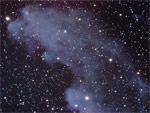Astrophotography by Bernhard Hubl |
||||||||||||||||||||||||||||||||||||||||||||||||||||||||||||||||||||||||||||||||||||||||||||||||||
|
NebulaeA nebula is an interstellar cloud of dust, hydrogen gas and plasma. It is the first stage of a star's cycle or it is a result of a star's death. The nebulae can be divided in five big classes:
1.Emission nebulae An emission nebula is a cloud of ionized gas emitting light of various colors. The most common source for ionization are high-energy photons emitted from a nearby hot star. Most emission nebulae show a dominant red color (Halpha line in HII regions).
2.Planetary nebulae A planetary nebula (PN) is a type of emission nebula, consisting of an expanding, glowing shell of ionized gas ejected from red giant stars late in their lives. Planetary nebulae can show strong emission in the [OIII] line, causing parts of the nebulae appear in a bluish/greenish color.
3.Supernova remnants A supernova remnant (SNR) is the structure resulting from the explosion of a star in a supernova. The supernova remnant is bounded by an expanding shock wave, and consists of ejected material expanding from the explosion, and the interstellar material it sweeps up and shocks along the way.
4. Reflection nebulae Reflection nebulae are clouds
of dust which are simply reflecting the light of a nearby star or stars.
The nearby star or stars are not hot enough to cause ionization in the gas
of the nebula like in emission nebulae but are bright enough to give
sufficient scattering to make the dust visible. A dark nebula is a type of interstellar cloud that is so dense that it obscures the light from the background emission or reflection nebula (e.g., the Horsehead Nebula) or that it blocks out background stars (e.g., the Coalsack Nebula).
|
|||||||||||||||||||||||||||||||||||||||||||||||||||||||||||||||||||||||||||||||||||||||||||||||||




